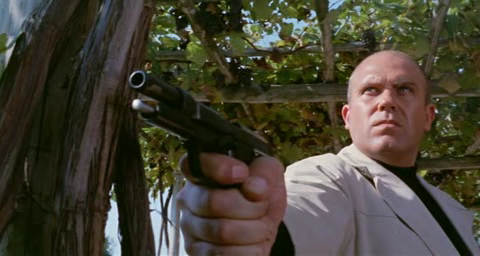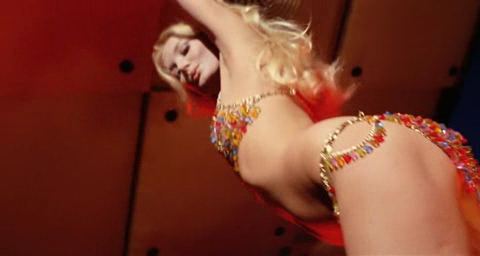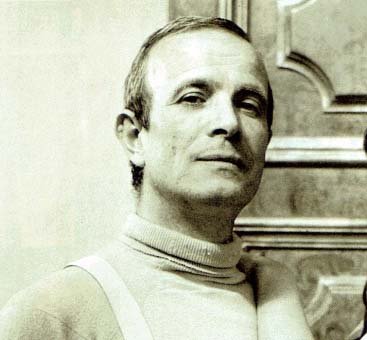
Caliber 9 (O.V. Milano Calibro 9)
Italy, 1972
Director: Fernando Di Leo
Script: Fernando Di Leo (based on a book by Giorgio Scerbanenco)
Cast: Gastone Moschin (Ugo Piazza), Barbara Bouchet (Nelly Borden), Mario Adorf (Rocco Musco), Frank Wolff (Inspector), Ivo Garrani (Don Vincenzo), Phillippe Leroy (Chino), Lionel Stander (Americano)
Music: Luis E. Bacalov, Osanna
Plot
Rocco Musco and an accomplice are supervising a dollar smuggling operation in Milan, carried out by couriers who have to chain-train a package full of banknotes. But when Rocco receives the package, he sees with astonishment and fury that instead of money it contains old newspapers. The clear consequence of this is that heads will roll: three of the couriers whose mission was to get the dollars to Milan are located, tortured and finally killed in a cave in the mountains with a charge of dynamite – without any clarification as to who was responsible for the theft.
One of the couriers, Ugo Piazza, managed to escape the cruel revenge; having been arrested after committing a robbery shortly afterwards. When Ugo is released from prison three years later, the henchmen of a powerful organized crime boss known as “Il Americano” (“The American”) are waiting for him… Among them Rocco, who is convinced that it was Ugo who hid the dollars three years earlier, and that in order to save himself he had himself arrested after a purposely ill-planned robbery…
Rocco and his henchmen drive Ugo to a garbage dump, and beat him up, taking his documents and the little money he has on him. Rocco insists that he go to see The American, to give him an explanation for the disappearance of his $300,000. But Ugo insists he had nothing to do with the theft of that money.
Ugo has no choice but to go to the police station to request a new provisional document (without which it would be impossible for him to find accommodation). He and the commissioner are old acquaintances. The police chief is aware of Ugo’s conflict with the Americano’s gang, as well as the issue of the missing money, and offers him protection in exchange for his collaboration as an informant. However, Ugo continues to insist that he knows nothing.
The commissioner, a tough, stubborn and fierce man, shares an office with his second in command, the more “progressive” Mercuri, the deputy commissioner. Mercuri has a broader vision of how organized crime really works, because he is convinced that above the American there are much “bigger fishes”, hidden under the cloak of “respectability”: bankers, politicians, etc. According to Mercuri, these are dedicated to using The Americano (who would be nothing more than a straw man) to carry out great capital escapes abroad. Without them, people like The Americano would have no power.
Meanwhile, Rocco and his men follow Ugo at all times, as they are sure that sooner or later he will make a false move and go to the place where he is hiding the $300,000 he is accused of stealing. Ugo has settled into a modest hotel, and the bandits go there to thoroughly search his room, destroying it in the process.
They find nothing, but Rocco urges him once again to come before the Americano.
Instead, Ugo goes to visit his former boss Don Vincenzo, now blind, who was displaced by The Americano. With Don Vincenzo also lives an old friend of Ugo’s named Chino (pronounced “Kino”). Both are practically retired from the world of crime, but Ugo asks for their protection so that he can face the gang of hitmen who are on his heels. Chino doesn’t seem to be willing to get into trouble with The Americano; a man who is too powerful and has “many influential friends above him and many unscrupulous people below him”. Yet he agrees to lend him the amount of money he needs to pay for the damage done to the hotel by The Americano’s henchmen. In this, Rocco shows up there with two of his thugs. When Don Vincenzo is threateningly harassed, Chino intervenes to defend his godfather and Ugo covers his back. Rocco is forced to return to Ugo the money Chino had just given him. When Rocco and his men have retired, Chino recommends Ugo to go see the American.
Ugo follows his friend’s advice, and goes to the offices of the important gangster boss. Surprisingly, The Americano wants to hire him, and puts him under Rocco’s command. Ugo imagines that this is a ploy, for what better way to get him under control than to readmit him into the organization.

That same night Ugo goes to a nightclub where his former girlfriend Nelly works as a dancer. From that moment on, the ex-convict moves in with her and the two resume their relationship. Nelly is also convinced that it was Ugo who three years earlier took the $300,000, but he once again proclaims his innocence. The dancer proposes that they leave together, “to Beirut”, but Ugo says that this would only confirm the suspicions that the Americano has against him.
Now that they have accepted him back into the gang, Ugo will try to find out who was really responsible for the disappearance of the money…

Commentary
“Milano Calibro 9” is one of the most remarkable masterpieces of Italian film noir (known as polizziesco). The director Fernando Di Leo, who has an enormous talent for scriptwriting (he collaborated with Sergio Leone in the development of the “Dollar Trilogy”), based himself on a series of detective stories by novelist Giorgio Scerbanenco set in Milan.
The viewer is kept in tension from the brutal and unforgettable start of the film (accompanied by the excellent soundtrack of Argentinian Luis E. Bacalov) to the apotheosis of the surprise ending. Towards the last part of the film, there are several turns of the script that make the intrigue grow exponentially.
Ugo tries to play a “Trojan horse” role in the Americano’s gang while this one and his right arm Rocco keep him constantly under control. At the same time, the commissioner tries to turn the released prisoner into a police informer, taking advantage of the delicate situation he finds himself in. But Ugo only trusts his friend Chino and his girlfriend Nelly (with whom he resumes an idyll after three years in prison).
“Milano Calibro 9” is the first film of the so-called “Trilogia del milieu” (or “Trilogia della Malavita” – of the “bad life”, i.e. of crime, or of the underworld). Shortly afterwards Di Leo would film “La mala ordina” (1972) and “Il Boss” (1973).
The hieratic protagonist Ugo Piazza is played by Gastone Moschin (the evil Don Fanucci from “The Godfather II”, F.F. Coppola, 1974). The Czech Barbara Bouchet plays his girlfriend Nelly, a sensual dancer of dubious reputation. The American is Lionel Stander (who we can see in a small supporting role as a barista in “Once upon a time in the West” by Sergio Leone, 1968). But without a doubt, the most outstanding of the cast is the Italian-German Mario Adorf, who shines by bringing to life the histrionic and gestural Rocco Musco – a gangster with a sarcastic sense of humor and explosive temperament reminiscent of Eli Wallach as Tuco in “The Good, the Ugly and the Bad” (Sergio Leone, 1966) and whom Joe Pesci could well have taken as a reference for the characters he plays in “Goodfellas” (1990) and “Casino” (1995), both by Martin Scorsese (who is, by the way, like Tarantino, a great admirer of the polizziesco genre from the Italian “motherland”).

Director Fernando Di Leo (who can be seen at the beginning in a small cameo à la Hitchcock; he is the man who comes out of a telephone booth) shows a prodigious capacity for constructing stories with a hook and for developing dialogues with sharp, ingenious and powerful phrases.
Also the subplots and conflicts between the secondary characters fit very well into the whole, are masterfully woven and are of great interest. This is where the confrontation between the two police officers comes in; the “fascist” commissioner (who categorically states that “criminals are born” or that “amnesty is a stimulus to commit crimes”) and his right-hand Mercuri, a more thoughtful and reasonable man who dislikes the daily methodology of repression against petty thieves while at the same time, “white-collar” criminals (such as big bankers and corrupt politicians) are allowed to roam free. In his opinion, the latter do more harm to society than the former – and petty criminals would not even exist if it were not for the “respectable” criminals.
Just as there is a frontal opposition between these two agents of the law and their respective ideas, a dichotomy is also established between the two chiefs of crime: on the one hand, the blind godfather Don Vincenzo, a “man of honor” (although finished and ruined) who represents the “old school”; and on the other, the American, a very dangerous, overbearing and unscrupulous individual who does not hesitate to get into new businesses like drugs and to treacherously murder anyone who dares to get in his way. In this way, we not only have the “good cop” and the “bad cop”, but also the “good gangster” and the “bad gangster” (Don Vincenzo: “If this continues, they will create an anti-mafia commission for Milan… Today, they call anything mafia, but all that remains are just gangs. The real Mafia no longer exists”).
The film music was composed by Luis Enríquez Bacalov (Di Leo’s usual collaborator) with the participation of the Osanna, a progressive-psychedelic rock band. Di Leo would use the same soundtrack again, recycling it for other of his later films, such as “La città sconvolta: Caccia spietata ai rapitori” (1975), with Luc Merenda or “Vacanze per un massacro” (1980), with Joe D’Alessandro.
Get Mafia Films: A Guide HERE!
Get Milano Calibro 9 HERE!
(This is an affiliate link. I may earn a commission if you purchase through these link, at no extra cost to you. As an Amazon Associate, I earn from qualifying purchases.)
Get Fernando Di Leo Crime Collection 4-Disc Box Set HERE!
(This is an affiliate link. I may earn a commission if you purchase through these link, at no extra cost to you. As an Amazon Associate, I earn from qualifying purchases.)
